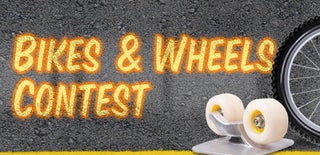Introduction: Reclaimed Wood Skateboard
Its summertime which means it is time to enjoy the long days and warm weather. One of my favorite summertime activities is cruising on a skateboard. I designed this board to be cheap, durable, and simple. I drew my inspiration for this board from the Z-boys. An innovative group of teens from 1970's Venice, CA, the Z-boys were surfers who evolved the sport of skateboarding. I read that some of them would cut and shape there dresser drawers and attatched rollerskate wheels to make their own boards. With my inspiration in hand its time to start.
Step 1: Wood Selection and Shape
Wood
A couple years ago my dad and I took apart an old, solid wood cabinet. I stacked the wood and stored it to the side waiting for another day(pic #1). The cabinet was made of three quarter inch pine. Normally I would not recomend a soft wood for a skateboard, a hardwood like maple or oak would be stronger and more durable. Although this board came from an old growth tree and contained 67 growth rings in just five inches meaning it is much denser and stronger then todays pine. So find yourself an old board or some thick plywood and get started.
Shape
I went for an old 70's cruiser style shape. The shape is simple and models after the original skateboard. Create your own design or trace another board, your call. Draw your design onto the wood and test the shape by standing on it.
Step 2: Shaping
I used a jigsaw to cut the shape, although anything could be used(such as a hacksaw). After cutting out the board I shaped it smooth and symmetrical using a belt sander(pic #1). I then rounded the edges using a handplane and 100 grit sandpaper(pic #2).
*remember to protect your lungs
Step 3: Flattening and Drilling Truck Holes
Flattening
If your board is nice and flat then skip this step. I flattened the board using a stanley jack plane(pic #1). Anything can be used like sand paper or even a pocket knife held at a 90 degree angle.
Drilling
This step requires the most precision or your board may end up looking like cheese. The easiest method is to draw a line straight down the middle of the board and the draw a line through the middle of the trucks(what the wheels attach to). Slide your trucks up and down the board finding the sweet spot for the wheels. My truck positions were 2 inches from the nose and 6 inches from the tail. If you have risers(a rubber pad that sits between board and trucks) they can be taped in the correct position(pic #3). If not then make a tracing of the trucks. Before drilling the holes, place a piece of scrap wood under the board to prevent tearout(pic #2).
Step 4: Final Sanding and Sealing
Sanding
I sanded the whole board with 100 grit sandpaper. The wood is smooth but still contains some grip which is essential. I also sanded away some paint to exaggerate the age and make the board apear old and used.
Sealing
For sealing I applied 3 coats of linseed oil followed by 1 coat of polyurethane.
Griptape
As you can see, I did not apply griptape because I wanted the grain to show off. Your call.
Step 5: Finish
Hardware
With the deck finshed, now is the time to apply the trucks and wheels. I had to pick up some longer pan head screws with nuts at a big box hardware store. The hardware cost about three bucks, my only expense on the board.
My board
The reclaimed, old pine deck is finally complete and came in at 11/16 of an inch. I set my deck up with some black independent trucks and threw on some tunnel rock wheels i got off an old board. It was a fun experience making the board although the best part is riding, so get out and design your own board. Be inovative or keep it simple. It always feels good to feel the wind in your face, but on your own board it is different so enjoy the summer one push at a time.

Runner Up in the
Bikes and Wheels Contest













